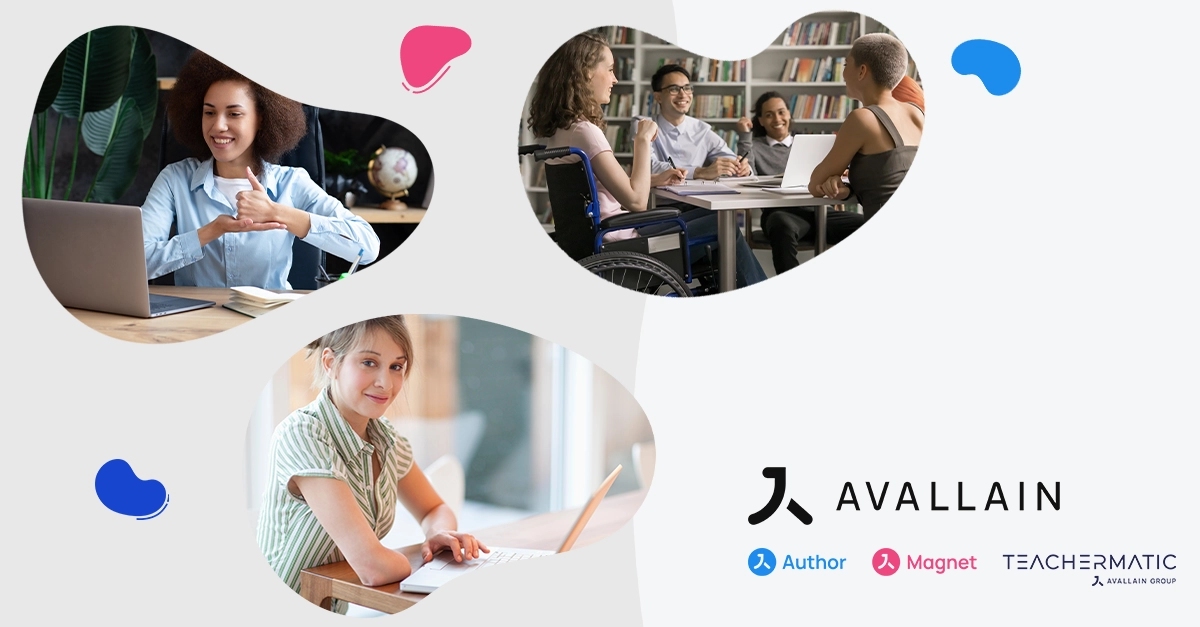
6 min read
2021/09/27
New to eLearning? You probably have some questions. With so many terms, concepts, and eLearning products floating around, it’s difficult to find the right solution for your organisation’s needs. This list of eLearning software FAQs should clear up some of the basics.
At Avallain, we get a lot of questions about eLearning software. And with the demand for eLearning increasing, organisations are searching for solutions to meet this demand. If you’re the person tasked with implementing an eLearning program, then you’ve come to the right place.
These FAQs will give a level of base knowledge to make an informed decision when looking for an eLearning software solution for your organisation.
eLearning Software: 15 Frequently Asked Questions
#1. What is eLearning?
eLearning is short for electronic learning. It’s a catch-all term for any learning content delivered electronically.
It’s a way of learning that enables publishers, businesses, and educational institutions to distribute engaging and effective courses that help people learn new skills, employees gain new certifications, and students succeed in their studies.
#2. What is eLearning software?
eLearning software is a term that can cover a wide swath of software applications. At a top-level, these are programs that create, administer, publish, and track any kind of eLearning course or activity.
Once delivered offline, these software solutions have taken on a software-as-a-service (SaaS) model, which offers a higher level of performance and flexibility.
#3. What are the different types of eLearning software?
There are four main categories of eLearning software. They all fulfill different functions, and they can be used separately or in any combination depending on your needs.
- Online Authoring Tools – These are tools that are solely used to create eLearning content. They can deliver that content via an API or by publishing directly to a connected learning platform.
- Learning Management System (LMS) – A software application made specifically for the administration and delivery of eLearning courses. An LMS helps you manage every stage of delivering learning to an audience.
- Learning Experience Platform (LXP) – A newer application that’s making a splash in the online training industry, an LXP is essentially and LMS with higher level functions to foster a better user experience. These functions include gamification, personalised dashboards, reporting capabilities, and artificial intelligence.
- Comprehensive or All-In-One Software – These programs deliver both authoring and distribution functions into one package. They allow you to create, deliver, and manage the learning experience from start to finish. Platforms like these have grown very popular because you can get the benefits of two platforms for the price of one. Avallain Magnet is a perfect example of these software packages. It’s a seamless and easy-to-use bespoke LMS and LXP with authoring capabilities built in.
#4. What are the different types of eLearning?
eLearning courses can come in many forms. Some of the most popular include lectures and seminars delivered in audio or video format. eLearning can even be delivered in eBooks and interactive games and quizzes.
#5. What features should you look for in an eLearning software?
Each business has its own goals, and a bespoke eLearning software can help businesses reach their goals. Some general qualities businesses should consider include the ease of use, user experience, level of interactivity, accessibility, security, and customisability.
#6. How do you create content with eLearning software?
The specifics on how to create content depend on the software you choose, but there are some general tips to creating great content for learning.
- Break It Up – It’s important to keep your learning content organised. Break your content up into courses and modules, that way it’s easily digestible for your audience. Plus, it’s easier to keep track of on the admin end.
- Use Multimedia – Interactivity has a profound impact on learning outcomes. Make sure to incorporate a variety of media forms into your eLearning courses.
- Prioritise Interactivity – Make sure to take the time and ask your learners to interact with the material. Whether through quizzes, games, or other tools, getting learners directly involved in their learning always leads to better results.
#7. What sort of media can eLearning software support?
Not all eLearning software can support all forms of online media. That’s why it’s important to find a software that can. Multimedia learning content is a key to keeping your learners engaged.
Whether you’re looking to create engaging infographics, PDFs, video, audio, or even fully functional games, the right eLearning authoring software can help.
#8. How interactive can eLearning be?
The quick answer is very interactive! And the more interactive, the better.
With the advancements in authoring software and LXP’s, eLearning is more interactive than ever before. Multimedia content creates plenty of opportunities for the learner to take complete control over their learning experience.
#9. Is eLearning accessible to people with different learning styles?
Definitely! The great thing about eLearning software is that they can support all forms of online media, allowing you to create a variety of learning content that resonates with all learning styles. Be sure to test your engagement to find out what works best for your learners.
#10. Can eLearning software publish content to all devices, including desktop and mobile?
Yes, and that should be something you look for. One of the best parts about eLearning is the flexibility it provides for the end user. And with the right software, they can learn on a tablet at the library. Then they can continue that module at their home office on a desktop computer. Later on, they can pick it back up on their morning commute through their phone.
#11. Can you integrate existing courses or in-person courses with eLearning software?
Yes! In fact, a blended learning environment can be highly effective, allowing you to get the full benefits of eLearning and in-person learning. The best eLearning software provide that flexibility.
#12. Can eLearning software create e-books?
Again, not all eLearning software is created equal. Some eLearning software packages have limited capabilities in this area. It’s important to verify what each software package you’re considering can and can’t do.
The right eLearning authoring tools (like Avallain Author) can help you compile and manage content into cohesive eBooks ready for publishing.
#13. Who can or should use eLearning software?
Anyone can use eLearning, and the right solution will vary, depending on their industry, their needs, and their objectives.
Traditionally, eLearning has been boosted by publishers, educational institutions, and publishers, but small, mid-sized and large businesses are also taking their piece of the cake, after seeing the advantages of online training, bespoke learning content,
#14. How does eLearning software benefit businesses?
The right eLearning solution can spark growth in your employees and, as a result, your entire business. eLearning benefits organisations by providing easy and comprehensive solutions to onboarding, professional development, compliance, culture, certifications, and change management. We cover these benefits in a lot more detail in this blog post.
#15. How does eLearning software benefit schools and universities?
eLearning solutions enable schools and universities of all sizes around the world to develop their own interactive digital education content. These assets can be courses unto themselves, or they can supplement existing courses. They allow universities to enroll students across the globe, expanding their offerings and reach.
Conclusion
There are a lot of eLearning software programs out there, so having a basic knowledge of what’s available and how it can be used to benefit your organisation will help you find the right solution.
Now that you know the basics, ready to find out more about how eLearning can benefit your organisation? Avallain can help. Contact us today and tell us about your needs.


